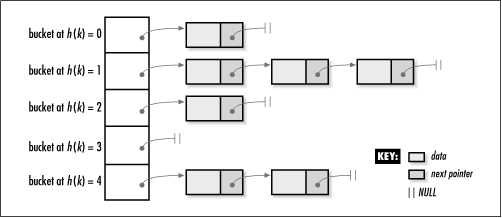Description of Chained Hash Tables
A chained hash table fundamentally consists of an array of linked lists. Each list forms a bucket in which we place all elements hashing to a specific position in the array (see Figure 8.1). To insert an element, we first pass its key to a hash function in a process called hashing the key. This tells us in which bucket the element belongs. We then insert the element at the head of the appropriate list. To look up or remove an element, we hash its key again to find its bucket, then traverse the appropriate list until we find the element we are looking for. Because each bucket is a linked list, a chained hash table is not limited to a fixed number of elements. However, performance degrades if the table becomes too full.

Collision Resolution
When two keys hash to the same position in a hash table, they collide. Chained hash tables have a simple solution for resolving collisions: elements are simply placed in the bucket where the collision occurs. One problem with this, however, is that if an excessive number of collisions occur at a specific position, a bucket becomes longer and longer. Thus, accessing its elements takes more and more time.
Ideally, we would like all buckets to grow at the same rate so that they remain nearly the same size and as small as possible. ...
Get Mastering Algorithms with C now with the O’Reilly learning platform.
O’Reilly members experience books, live events, courses curated by job role, and more from O’Reilly and nearly 200 top publishers.

